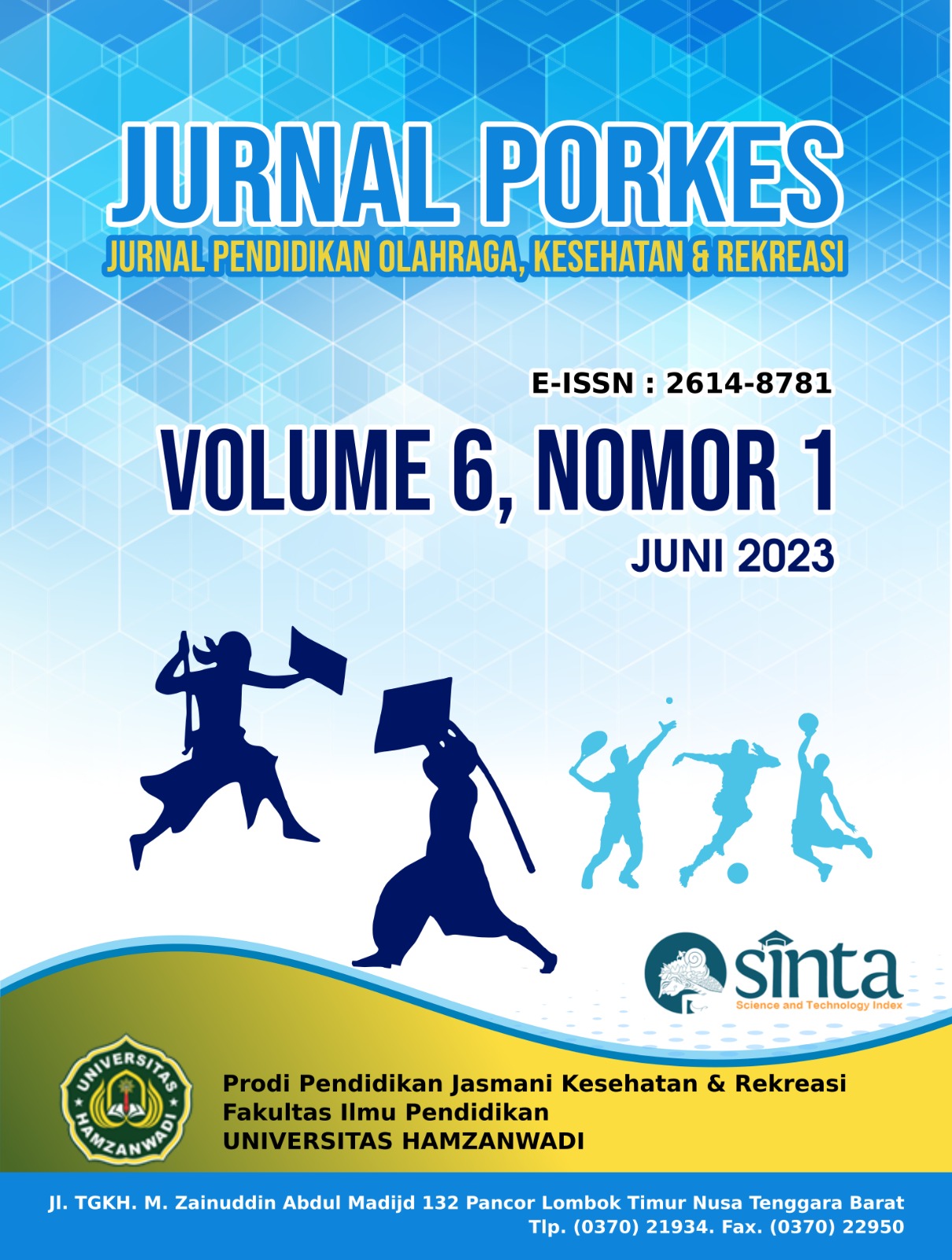Faktor penentu keputusan pemilihan sekolah taekwondo
DOI:
https://doi.org/10.29408/porkes.v6i1.7653Keywords:
Decision factors, taekwondo school, selectionAbstract
Problems in research studies on the sports service industry, understanding, achievement, image, and promotion determine school selection. This study aims to determine understanding, achievement, image, promotion determine the selection of taekwondo schools. This research method uses qualitative methods with a descriptive approach, the study population is representatives of trainers and 20 guardians of taekwondo students and data collection techniques by observation, interviews, questionnaires and documentation are then analyzed by data reduction, data presentation, conclusion and verification. With the results found that community taekwondo achievements require consideration of taekwondo schools that have achievements, it is hoped that the community by participating in taekwondo can have achievements. The community chooses a taekwondo school, it is necessary to consider a good school image, because it considers the child's character factor. Taekwondo promotions are carried out through individuals and taekwondo schools carry out promotions through social media such as instagram, facebook, whatsapp. the conclusion is that the election of the community has reasons in determining the selection of a taekwondo school, namely understanding, achievement, image and promotion determine the choice of the community to choose a taekwondo school.
References
Abdussamad, Z. (2021). Metode Penelitian Kualitatif (P. Rapanna (ed.); Cetakan Pe). CV Syakir Media Press.
Alfariza, G., & Suranto. (2022). Strategi Komunikasi Interpersonal Pelatih Bagi Prestasi Atlet Taekwondo Rahmi Kurnia Taekwondo School Daerah Istimewa Yogyakarta. Jurnal Lektur, 5(1), 44–51. https://doi.org/10.21831/lektur.v5i1.19140
Amruddin, Muskananfola, I. L., Febriyanti, E., Badi’ah, A., Pandie, F. R., Yasintha, M., Martiningsih, Y., Letor, K., Pratiwi, R. D., Berimbing, M. A., Paulus, A. Y., Selly, J. B., Tahu, S. K., Sarjana, S., Israfil, Feoh, F. T., Lette, A. R., Christianto, H., Tage, P. K. S., Djaniar, U. (2022). Metodologi Penelitian Kuantitatif dan Kualitatif (A. Munandar (ed.); Cetakan pe). CV. Media Sains Indonesia.
Anggito, A., & Setiawan, J. (2018). Metodologi Penelitian Kualitatif (E. D. Lestari (ed.); Cetakan Pe). CV Kekas.
Bangun, S. Y. (2016). Peran Pendidikan Jasmani dan Olahraga pada Lembaga Pendidikan di Indonesia. Publikasi Pendidikan, 6(3), 156–167. https://doi.org/10.26858/publikan.v6i3.2270
Fatoni, M., & Subekti, N. (2022). Peran Keterikatan Suporter Sepak Bola pada Klub. JUARA : Jurnal Olahraga, 7(2), 476–489. https://doi.org/10.33222/juara.v7i2.1679
Firmandana, I., Ramadhan, M., & Sobirin. (2020). Penerapan Metode Copras pada Sistem Pendukung Keputusan Pemilihan Calon Ketua Pengkot Taekwonodo. Jurnal Cyber Tech, 3(4), 748–757. https://ojs.trigunadharma.ac.id/index.php/jct/article/view/3904
Fitrah, M., & Luthfiyah. (2017). Metodologi Penelitian Penelitian Kualitatif, Tindakan Kelas & Studi Kasus (Rusian & M. M. Effendi (eds.); Cetakan Pe). CV Jejak.
Fradito, A., Suti’ah, S., & Muliyadi, M. (2020). Strategi Pemasaran Pendidikan dalam Meningkatkan Citra Sekolah. Al-Idarah : Jurnal Kependidikan Islam, 10(1), 12–22. https://doi.org/10.24042/alidarah.v10i1.6203
Harahap, N. (2020). Penelitian Kualitatif (H. Sazali, F. Jamaludin, & A. Husein (eds.); Cetakan Pe). Wal Ashri Punlishing Jl. Ekarasmi Medan Sumatera Utara. http://repository.uinsu.ac.id/9105/1/Buku
Metodologi Penelitian Kualitatif Dr. Nursapia Harahap, M.Hum.pdf
Jariono, G., Subekti, N., Indarto, P., Hendarto, S., Nugroho, H., &
Fachrezzy, F. (2020). Analisis Kondisi Fisik Menggunakan Software Kinovea pada Atlet Taekwondo Dojang Mahameru Surakarta. Transformasi: Jurnal Pengabdian Masyarakat, 16(2), 133–144. https://doi.org/10.20414/transformasi.v16i2.2635
Kencana, W. H., Situmeang, I. V. O., Meisyanti, Rahmawati, K. J., & Nugroho, H. (2022). Penggunaan Media Sosial dalam Portal Berita Online. Jurnal Sosial Dan Humaniora, 6(2), 136–145. https://journals.upi-yai.ac.id/index.php/ikraith-humaniora/article/view/1509
Kotler, P., Wong, V., Saunders, J., & Armstrong, G. (2012). Principles of Marketing. Fourth European Edition. In Pearson (Vol. 38, Issue 151). https://library.wbi.ac.id/repository/212.pdf
Lenaini, I. (2021). Teknik Pengambilan Sampel Purposive dan Snowball Sampling. Jurnal Kajian, Penelitian & Pengembangan Pendidikan Sejarah (Jurnal Historis), 6(1), 33–39. https://doi.org/10.31764/historis.v6i1.4075
Maulida. (2020). Teknik Pengumpulan Data dalam Metodologi Penelitian. Jurnal Darussalam, 21(2). http://dx.doi.org/10.58791/drs.v21i2.39
Nasution, A. F. (2023). Metode Penelitian Kualitatif (M. Albina, Zulfa, & Nita (eds.)). CV. Harfa Creative.
Nelly, R., & Paramita, S. (2019). Makna Simbolik dalam Konteks Komunikasi Antar Budaya (Kajian Fenomenologi Terhadap Seni Bela Diri Taekwondo). Jurnal Koneksi, 2(2), 532–539. https://doi.org/10.24912/kn.v2i2.3933
Nugroho, S. (2019). Industri Olahraga (S. Amalia (ed.); Edisi Pert). UNY Press, Anggota Ikapi Penerbit Indonesia, Jl. Gejayan Gg. Alamanda Komplek Fakultas Teknik UNY.
Ruskin. (2019). Metodologi Penelitian Kualitatif (Cetakan Pe). Yayasan Ahmar Cendekia Indonesia.
Setianto, W. R., Widijoto, H., & Sulistyorini. (2017). Pengembangan Latihan Taekwondo dengan Media Audio-Visual untuk Ekstrakurikuler Taekwondo di SMA Kabupaten Tulungagung. Jurnal Gelanggang Pendidikan Jasmani Indonesia, 1(1), 30–39. http://dx.doi.org/10.17977/um040v1i1p30-39
Siregar, I. (2022). Menganalisis Pengembangan Latihan Taekwondo pada Ekstrakulikuler Taekwondo di Sekolah Dasar Harapan. Jurnal Terapan Ilmu Pengetahuan, 1(1), 62–65. http://bredujtip.com/index.php/JTIP/article/view/24
Sumertajaya, I. K. S. W. (2022). Implikasi Perubahan Undang-Undang Keolahragaan Terhadap Pengupahan Bagi Olahragawan Profesional. Jurnal Ilmiah Raad Kertha, 5(2), 30–41. https://doi.org/10.47532/jirk.v5i2.684
Tirtawirya, D. (2005). Perkembangan dan Peranan Taekwondo dalam Pembinaan Manusia Indonesia. Jurnal Olahraga Prestasi (JORPRES), 1(2), 195–211. https://journal.uny.ac.id/index.php/jorpres/article/view/6869
Tutiyani, & Diandra, D. (2018). Rekomendasi Strategi Pemasaran Organisasi Beladiri Dojang Taekwondo Taman Alfa Indah Sacti Club. Jurnal Akuntansi Dan Manajemen, 15(1), 131–142. https://doi.org/10.36406/jam.v15i01.148
Wardani, D. L., Pusari, R. W., & Wakhyudin, H. (2019). Ekstrakulikuler Taekwondo dalam Kerja Keras. JET Jurnal of Education Technology, 3(3), 167–171. https://doi.org/10.23887/jet.v3i3.21741
Downloads
Published
How to Cite
Issue
Section
License
![]()
Jurnal Porkes is licensed under a Creative Commons Attribution-Share Alike 4.0 International License







